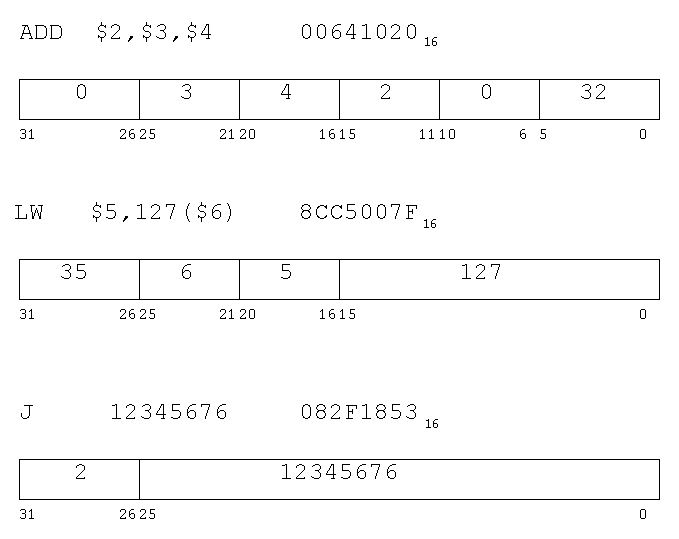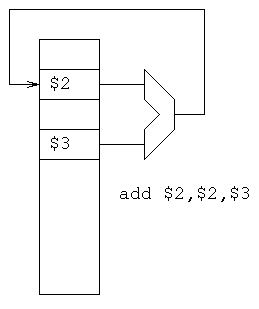now look at instructions in memory, how they got there and
how they execute:
1. Start by using an editor to enter compiler language statements.
The editor writes your source code to a disk file.
2. A compiler reads the source code disk file and produces
assembly language instructions for a specific ISA that
will perform your compiler language statements. The assembly
language is written to a disk file.
3. An assembler reads the assembly language disk file and produces
a relocatable binary version of your program and writes it to
a disk file. This may be a main program or just a function or
subroutine. Typical file name extension is .o or .obj
4. A linkage editor or binder or loader combines the relocatable
binary files into an executable file. Addresses are relocated
and typically all instructions are put sequentially in a code
segment, all constant data in another segment, variables and
arrays in another segment and possibly making other segments.
The addresses in all executable files for a specific computer
start at the same address. These are virtual addresses and the
operating system will place the segments into RAM at other
real memory addresses. Windows file extension .exe
5. A program is executed by having the operating system load the
executable file into RAM and set the program counter to the
address of the first instruction that is to be executed in
the program. All programs might have the same starting address,
yet the operating system has set up the TLB to translate the
virtual instruction and data addresses to physical memory addresses.
The physical addresses are not available to the program or to a
debugger. This is part of the security an operating system
provides to prevent one persons program from affecting another
persons program.
A simple example:
Compiler input int a, b=4, c=7;
a = b + c;
Assembly language fragment (not unique)
lw $2,12($fp) b at 12 offset from frame pointer
lw $3,16($fp) c at 16 offset from frame pointer
add $2,$2,$3 R format instruction
sw $2,8($fp) a at 8 offset from frame pointer
Memory addresses in bytes, integer typically 4 bytes, 32 bits.
Loaded in machine
virtual address content 32-bits 8-hexadecimal digits
00000000 8FC2000C lw $2,12($fp)
00000004 8FC30010 lw $3,16($fp)
00000008 00000000 nop inserted for pipeline
0000000C 00431020 add $2,$2,$3
00000010 AFC20008 sw $2,8,($fp)
$fp has 10000000 (data frame)
10000000 00000000
10000004 00000001
10000008 00000000? a after execution
1000000C 00000004 b
10000010 00000007 c
Instruction field format for add $2,$2,$3
0000 0000 0100 0011 0001 0000 0010 0000 binary for 00431020 hex
vvvv vvss ssst tttt dddd dhhh hhvv vvvv 6,5,5,5,5,6 bit fields
0 | 2 | 3 | 2 | 0 | 32 decimal values of fields
Instruction field format for lw $2,12($fp) $fp is register 30
1000 1111 1100 0010 0000 0000 0000 1100 binary for 8FC2000C hex
vvvv vvxx xxxd dddd aaaa aaaa aaaa aaaa 6,5,5,16 bit fields
35 | 30 | 2 | 12 decimal values of fields
The person writing the assembler chose the format of an assembly
language line. The person designing the ISA chose the format of
the instruction. Why would you expect them to be in the same order?
 A very simplified data flow of the add instruction. From the
registers to the ALU and back to the registers.
A very simplified data flow of the add instruction. From the
registers to the ALU and back to the registers.
 The VHDL to use the ALU will be given to you as:
ALU: entity WORK.alu_32 port map(inA => EX_A,
inB => EX_aluB,
inst => EX_IR,
result => EX_result);
We will call the upper input "A" and the lower input "B"
and the output "result".
The extra input, EX_IR, not shown on the diagram above
is the instruction the ALU is to perform, add, sub, etc.
The instructions we will use in this course are specifically:
cs411_opcodes.txt
Each student needs to understand what the instructions are
and the use of each field in each instruction.
(Note: a few have bit patterns different from the book and
different from previous semesters in order to prevent copying.)
Our MIPS architecture computer uses five clocks to execute
a load word instruction.
1 0 0 0 1 1 x x x x x r r r r r ---2's complement address------ lw r,adr(x)
1. Fetch the instruction from memory
2. Decode the instruction and read the value of register xxxxx
3. Compute the memory address by adding the sign extended bottom
16 bits of the instruction to the contents of register xxxxx.
4. Fetch the data word from the memory address.
5. Write the data word from memory into the register rrrrr.
When we cover "pipelining" you will see why five clocks are
used for every instruction, even though some instructions
need less than five.
Computer languages come in many varieties.
The information above applies to languages such
as C, C++, Fortran, Ada and others.
Many languages abstract the concept of binary relocatable
code, in what was originally called "crunch code".
These languages use their own form of intermediate files.
For example Pascal, Java, Python and others.
Other languages directly interpret the users source
files, possibly with some preprocessing.
For example SML, Haskel, Lisp, MatLab, Mathematica and
others.
With a completely new computer architecture, the first
"language" would be an assembly language. From this,
a primitive operating system would be built. Then,
typically an existing C compiler would be modified
for the new computer architecture. An alternative is
to build a cross compiler from C and gas, to
bootstrap existing code to the new architecture.
From then on, "reuse" goes into full effect and
millions of lines of existing software can be
running on the new computer architecture.
The VHDL to use the ALU will be given to you as:
ALU: entity WORK.alu_32 port map(inA => EX_A,
inB => EX_aluB,
inst => EX_IR,
result => EX_result);
We will call the upper input "A" and the lower input "B"
and the output "result".
The extra input, EX_IR, not shown on the diagram above
is the instruction the ALU is to perform, add, sub, etc.
The instructions we will use in this course are specifically:
cs411_opcodes.txt
Each student needs to understand what the instructions are
and the use of each field in each instruction.
(Note: a few have bit patterns different from the book and
different from previous semesters in order to prevent copying.)
Our MIPS architecture computer uses five clocks to execute
a load word instruction.
1 0 0 0 1 1 x x x x x r r r r r ---2's complement address------ lw r,adr(x)
1. Fetch the instruction from memory
2. Decode the instruction and read the value of register xxxxx
3. Compute the memory address by adding the sign extended bottom
16 bits of the instruction to the contents of register xxxxx.
4. Fetch the data word from the memory address.
5. Write the data word from memory into the register rrrrr.
When we cover "pipelining" you will see why five clocks are
used for every instruction, even though some instructions
need less than five.
Computer languages come in many varieties.
The information above applies to languages such
as C, C++, Fortran, Ada and others.
Many languages abstract the concept of binary relocatable
code, in what was originally called "crunch code".
These languages use their own form of intermediate files.
For example Pascal, Java, Python and others.
Other languages directly interpret the users source
files, possibly with some preprocessing.
For example SML, Haskel, Lisp, MatLab, Mathematica and
others.
With a completely new computer architecture, the first
"language" would be an assembly language. From this,
a primitive operating system would be built. Then,
typically an existing C compiler would be modified
for the new computer architecture. An alternative is
to build a cross compiler from C and gas, to
bootstrap existing code to the new architecture.
From then on, "reuse" goes into full effect and
millions of lines of existing software can be
running on the new computer architecture.
The blog provides study material for Computer Science(CS) aspirants. Mostly says "material nahi milta, padhun kahan se.", I think If you can not find content on the Internet, then you are not a CS student. Dedicated to (Prof. Rakesh Kumar, DCSA, K.U.Kurukshetra, HARYANA, INDIA)- "Ek teacher ka bahut jyada padhna, bahut jyada jaroori hota hai."
Monday, 24 June 2013
CPU Operation
Subscribe to:
Post Comments (Atom)
No comments:
Post a Comment